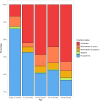Molecular Methods Enhance the Detection of Pyoderma-Related Streptococcus pyogenes and emm-Type Distribution in Children
- PMID: 39008379
- PMCID: PMC11793063
- DOI: 10.1093/infdis/jiae359
Molecular Methods Enhance the Detection of Pyoderma-Related Streptococcus pyogenes and emm-Type Distribution in Children
Abstract
Background: Streptococcus pyogenes-related skin infections are increasingly implicated in the development of rheumatic heart disease (RHD) in lower-resource settings, where they are often associated with scabies. The true prevalence of S pyogenes-related pyoderma may be underestimated by bacterial culture.
Methods: A multiplex quantitative polymerase chain reaction (qPCR) assay for S pyogenes, Staphylococcus aureus, and Sarcoptes scabiei was applied to 250 pyoderma swabs from a cross-sectional study of children aged <5 years in The Gambia. Direct PCR-based emm-typing was used to supplement previous whole genome sequencing (WGS) of cultured isolates.
Results: Pyoderma lesions with S pyogenes increased from 51% (127/250) using culture to 80% (199/250) with qPCR. Compared to qPCR, the sensitivity of culture was 95.4% for S pyogenes (95% confidence interval {CI}, 77.2%-99.9%) in samples with S pyogenes alone (22/250 [9%]), but 59.9% (95% CI, 52.3%-67.2%) for samples with S aureus coinfection (177/250 [71%]). Direct PCR-based emm-typing was successful in 50% (46/92) of cases, identifying 27 emm-types, including 6 not identified by WGS (total 52 emm-types).
Conclusions: Bacterial culture significantly underestimates the burden of S pyogenes in pyoderma, particularly with S aureus coinfection. Molecular methods should be used to enhance the detection of S pyogenes in surveillance studies and clinical trials of preventive measures in RHD-endemic settings.
Keywords: Streptococcus pyogenes; emm-typing; PCR; skin infection; strain diversity.
© The Author(s) 2024. Published by Oxford University Press on behalf of Infectious Diseases Society of America.
Conflict of interest statement
Potential conflicts of interest. A. J. K. has received training in immunoassay development and S pyogenes vaccine antigens through a Research Collaboration Agreement between GSK Vaccine Institute for Global Health, University of Sheffield, and London School of Hygiene and Tropical Medicine. No payments were made under this agreement. All other authors report no potential conflicts. All authors have submitted the ICMJE Form for Disclosure of Potential Conflicts of Interest. Conflicts that the editors consider relevant to the content of the manuscript have been disclosed.
Figures





